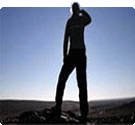East
Hiking routes

East Iceland is a paradise for the hiker, and locals are proud of their wide choice of walking trails. The possibilities include spectacular uninhabited areas with hikers’ huts, as well as short routes through vegetated valleys, over open sands, and along the seashore. Everyone can find something to suit themselves, whether they have a one-day trip or longer, more adventurous trekking in mind. Since hiking maps have been published for the greatest part of the region, it is easy to walk on your own, although there are also plenty of organised walking trips.
Culture
While the residents of East Iceland are few in number, their culture is rich and varied. Not only are they born among tales of elves, trolls, monsters and evil spirits, but have also been shaped by this awareness and the magnificent nature around them into individuals who know what they want. Everything from the difficult fight for existence in earlier centuries to the technological revolution of the 20th century is interestingly illustrated at the museums and centres distributed throughout the region. Residents sponsor and themselves participate in events such as art shows, plays, concerts and local festivals, and welcome visitors to have fun with them.
The Fjords

A prominent feature of East Iceland is its deep fjords, extending between high mountainsides with their slightly sloping Tertiary basalt strata. Rich fishing grounds led to settlements at convenient harbour locations. Offshore, French sailors came to catch cod, and Norwegian entrepreneurs initiated the construction of villages during the heydays of the herring and whaling industries. Times have changed; modern technology is now used for fishing and processing in the numerous busy fishing villages, where food for the connoisseur, such as the lobster caught off the Southeast Iceland glacial sands, is brought to dock.
The Woodlands
No other Icelandic region can boast of such varied, delightful woods as those of East Iceland. The woods of Bæjarstaðir in Skaftafell National Park contain some of Iceland’s prettiest, highest growing birch, protected by nature through the ages from the ravages of people and animals, while the famous forest at Hallormsstaður has long been considered the country’s leading woodland, with an arboretum nowhere paralleled at such northerly latitudes. Through the introduction of farm forestry in the valley area of Fljótsdalshérað and elsewhere in the East, green groves of trees are becoming ever more common where the traveller can stop and enjoy the vegetation and wind shelter.
Vatnajökull
Vatnajökull, Europe’s largest glacier, has shaped the environs and history of East Iceland for millennia. Most of the country’s rivers which have the greatest flow run from this glacier, thereupon forking through half of the island. In 2004, Europe’s largest national park was established, as the southern part of the glacier was added onto the Skaftafell park; moreover, further park expansion is being prepared. Farther north in the ice cap, Kverkfjöll combines the incredible forces of fire and glacial ice, while Vatnajökull Iceland’s most active volcano, Grímsvötn, erupts every 5-10 years. The massive glacial power appears again to the south as glacial tongues slide onto grassy plains and broad sands -- full reason for Vatnajökull to have placed its print on society through the centuries and for world-famous movies to have been filmed at the Jökulsárlón lagoon. Nonetheless, the stranger must beware of going onto the glacier, even if it is easilyaccessible at many points. It is wise to obtain information from those who are well acquainted with conditions, and both south and north of Vatnajökull there are trips and other services for glacier travellers.
Reindeer and Birds
Reindeer were brought to Iceland from Norway late in the 18th century. Today these majestic animals live only in East Iceland, seen above all in wild herds that prefer higher elevations in summer but seek lower reaches in winter. While their primary habitat is in the deserted expanses by Snæfell, reindeer are seen every year in the territory extending from Vopnafjörður in the north to the district of Suðursveit in the south. There is a strong demand for hunting permits, since reindeer meat is one of Icelandic nature’sgreatest delicacies. Conditions for bird watching can hardly be better than in Southeast Iceland, where Iceland’s only bird observatory is situated. Having winged their long way over the Atlantic, migrant as well as vagrant birds take a rest along the eastern coast. The sands around Jökulsárlón are the realm of the great skua, Eyjabakkar serves as a moulting area for the pink-footedgoose, and at Borgarfjörður you can walk up through the puffin colony.


 East Iceland is a paradise for the hiker, and locals are proud of their wide choice of walking trails. The possibilities include spectacular uninhabited areas with hikers’ huts, as well as short routes through vegetated valleys, over open sands, and along the seashore. Everyone can find something to suit themselves, whether they have a one-day trip or longer, more adventurous trekking in mind. Since hiking maps have been published for the greatest part of the region, it is easy to walk on your own, although there are also plenty of organised walking trips.
East Iceland is a paradise for the hiker, and locals are proud of their wide choice of walking trails. The possibilities include spectacular uninhabited areas with hikers’ huts, as well as short routes through vegetated valleys, over open sands, and along the seashore. Everyone can find something to suit themselves, whether they have a one-day trip or longer, more adventurous trekking in mind. Since hiking maps have been published for the greatest part of the region, it is easy to walk on your own, although there are also plenty of organised walking trips. A prominent feature of East Iceland is its deep fjords, extending between high mountainsides with their slightly sloping Tertiary basalt strata. Rich fishing grounds led to settlements at convenient harbour locations. Offshore, French sailors came to catch cod, and Norwegian entrepreneurs initiated the construction of villages during the heydays of the herring and whaling industries. Times have changed; modern technology is now used for fishing and processing in the numerous busy fishing villages, where food for the connoisseur, such as the lobster caught off the Southeast Iceland glacial sands, is brought to dock.
A prominent feature of East Iceland is its deep fjords, extending between high mountainsides with their slightly sloping Tertiary basalt strata. Rich fishing grounds led to settlements at convenient harbour locations. Offshore, French sailors came to catch cod, and Norwegian entrepreneurs initiated the construction of villages during the heydays of the herring and whaling industries. Times have changed; modern technology is now used for fishing and processing in the numerous busy fishing villages, where food for the connoisseur, such as the lobster caught off the Southeast Iceland glacial sands, is brought to dock.